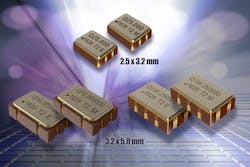Expanding “Spacescape” Impacting Oscillator Selection Criteria
High performance crystal oscillators have been and will remain a mainstay in orbital satellite applications. The spacescape—the range or orbits where satellites reside—is not a uniform environment. Geosynchronous (GEO) and Medium-altitude (MEO) satellites are often valued in the tens or even hundreds of millions of dollars and have a life expectancy of decades. As such, these very expensive systems demand maximum reliability for all components. LEO satellite clusters, in contrast, are made up of hundreds of far less expensive devices with life spans measured in years. In many of these applications, full space-qualified components are unnecessary and far too expensive.
This article will delve into the questions of what constitutes a “space-qualified” crystal oscillator and what differences there are, based on spacescape location. The article will also attempt to address the question of the applicability of commercial-off-the-shelf (COTS) crystal oscillators and micro-electromechanical systems (MEMS) oscillators versus New Space crystal oscillators in emerging satellite constellation applications.
The Many Regions in the Spacescape
The spacescape is defined as having four distinct regions – LEO, MEO, GEO and Deep Space, as described in Table 1.
Orbit Applications
LEO Communications, Earth Observation, Research, Imagery, Manned Spaceflight (ISS), Military, Space Observation, Spacecraft Repair, Supply Transport (ISS), and Weather
MEO: Communications, Navigation
GEO: Communications, Earth Observation, Military, Research, Space Exploration, Space Observation, Weather
Deep Space Exploratory Rover, Manned Spaceflight, Planet Exploration, Space Exploration
Table 1: Typical applications for earth-orbiting satellites.
As the distance from earth increases in these regions, the operational specifications and test criteria for electronic components become more stringent. For example, Solar ionizing radiation exposure increases with the altitude of orbit and the resulting reduction on the atmosphere’s ability to absorb/reflect its effects. The ability of a device to withstand the operational performance and expected longevity of operation is determined by the device’s ability to withstand a lifetime total ionizing dose (TID). The deeper into space, the higher the TID requirement.
Typical ranges for TID are shown in Table 2:
Orbit Industry Typical Q-Tech Devices
Deep Space 100 kRad up to 300kRad+
GEO 100 kRad 100 kRad+
MEO 100 kRad up to 100kRad
LEO 30 kRad up to 50 kRad
Table 2: TID – Typical ranges.
In the rapidly expanding LEO region, fully qualified “traditional space” components that meet the higher TID and other are demanding requirements (Table 3) to assure long mission operational life are far too expensive.
Lower quantity
Higher cost (up to $200,000 per device)
Long mission life
GEO / MEO orbits and Deep Space
HIGH RELIABILITY
Full Screening
Long Lead Times (24-52 weeks)
High Radiation Tolerance
Table 3: Traditional Space Components
It is estimated that “New Space” clusters of communications satellites will crowd the LEO region with upwards of 50,000 units within the next ten years. Moreover, the life-expectancy of these devices is typically 1-3 years, so the demand for components for these devices will grow to tens of thousands per year. In contrast to “Full Space” components, “New Space” crystal oscillators have different attributes (Table 4).
High quantity (constellations)
Lower cost ($60-$500) per device
Short mission life
LEO orbit
Lower-level screening or up-screening
Shorter delivery lead times (12-16 weeks)
Lower SWaP – Size, weight and power
Lower radiation tolerance
Table 4: New Space Components
Components for LEO satellite constellation applications utilize quartz crystal oscillators in miniature, lightweight packages. These, less expensive “New Space” oscillators use the same high-reliability manufacturing processes as full space devices, and their performance specs are the same or very similar, though the crystal is typically mounted on only 2 points. They do not require extensive quality control inspection (QCI), which reduces costs and speeds delivery. Even so, parts must still be fully screened to MIL-PRF-55310, level B plus PIND to verify performance (Table 5).
Standard Screening Tests per modified MIL-PRF-55310, Level B
· Temperature Cycling: MIL‐STD‐883, Method 1010, Condition B
· Constant Acceleration: MIL‐STD‐883, Method 2001, Condition A, Y1 only (5000 g's)
· Seal (Fine and Gross Leak): MIL‐STD‐883, Method 1014, Condition A1 and C
· Particle Impact Noise Detection (PIND): MIL‐STD‐883, Method 2020, Condition B
· Burn-in: MIL‐STD‐883, Method 1015, +125°C, nominal supply voltage and burn‐in load, 160 hours minimum
· Final Electrical Test: For Specified Parameters, Nominal and extreme supply voltages, specified load, +25°C and temperature extremes. PDA = 10% or 1 part
· External Visual: MIL‐STD‐883, Method 2009
Optional Tests
· GROUP A per MIL-PRF-55310 Level B
o Electrical: Supply Voltage, Input Current, Output Waveform, Rise and Fall Times, Duty Cycle, Start-Up Time, Overvoltage Survivability, and 10-point frequency stability test
· GROUP B
o Ageing: Oscillator is energized in oven for a continuous period of 30 days at 70ºC ±3ºC. The Output frequency is measured within an interval of 72 hours maximum per MIL-PRF-55310
Table 5: New Space Component Test Requirements
Where Do COTS Devices Fit In?
With the pressures of high demand and lower costs, the temptation of resorting to COTS devices is understandable. But, even with the lower life expectancy of these constellation satellites, the costs can be in excess of a million dollars per system. So, saving as little as $50 to use a device not fully tested for space application is a false choice.
At a recent SPACE TECH EXPO webinar [1], Chris Winslett of Lockheed Martin indicated that COTS devices were sometimes considered based on project development schedule and costs. He asked the question, “What’s the mission?” Non fully qualified space components are a useful choice when proving the mission. As Winslett said, “You don’t know the whole network until you get assets in orbit.”
COTS devices that are not certified for flight are an acceptable choice for bench testing and early program development, but not for space deployment, with the exception of proof of mission.
How About MEMS Oscillators?
In an earlier white paper titled, “Putting Crystal Oscillators in Their Rightful Place [2],” we provided a comparison of Crystal Oscillators vs. MEMS. In our view, as stated in that document, “…there are an enormous number of applications where MEMS oscillators are the preferred solution. The lower cost and acceptable performance levels make these devices ideal for high-volume consumer products including mobile phones, toys, games, automotive entertainment/navigation systems, to name a few. In some aerospace applications, where short-term performance (one and done) is important but long-term stability is not, MEMS might also be considered.”
“MEMS technology is making great inroads into oscillator applications where their lower cost offers an attractive solution. But the world of ultra-high reliability is and will remain the realm of the venerable crystal oscillator.”
Conclusion
The vast expansion of LEO satellite clusters is driving the demand for low cost yet highly reliable crystal oscillators. New Space components, manufactured using the same processes and materials as full-space qualified components and tested to a restricted but rigorous set of standards provide a cost effective solution without the reliability compromises that would result if COTS or MEMS devices were used.
References
1 Striking a Balance Between COTS and Custom-Made Space-Grade Components, March 23, 2021
2 Putting Crystal Oscillators in Their Rightful Place, Q-Tech White Paper, June 2019


